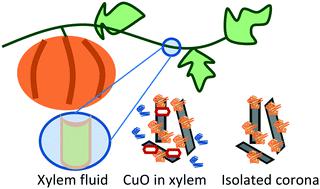当前位置:
X-MOL 学术
›
Environ. Sci.: Nano
›
论文详情
Our official English website, www.x-mol.net, welcomes your
feedback! (Note: you will need to create a separate account there.)
Biomolecular corona formation on CuO nanoparticles in plant xylem fluid
Environmental Science: Nano ( IF 5.8 ) Pub Date : 2021-3-25 , DOI: 10.1039/d1en00140j Jaya R. Borgatta 1, 2, 3, 4 , Christian A. Lochbaum 1, 2, 3, 4 , Wade H. Elmer 4, 5, 6, 7 , Jason C. White 4, 5, 6, 7 , Joel A. Pedersen 1, 2, 3, 4, 8 , Robert J. Hamers 1, 2, 3, 4
Environmental Science: Nano ( IF 5.8 ) Pub Date : 2021-3-25 , DOI: 10.1039/d1en00140j Jaya R. Borgatta 1, 2, 3, 4 , Christian A. Lochbaum 1, 2, 3, 4 , Wade H. Elmer 4, 5, 6, 7 , Jason C. White 4, 5, 6, 7 , Joel A. Pedersen 1, 2, 3, 4, 8 , Robert J. Hamers 1, 2, 3, 4
Affiliation

|
Biomolecular coatings (coronas) that form on nanomaterials have been widely investigated in animal and bacterial cell culture and in the extracellular and intracellular fluids of animals. Such coronas influence the distribution of nanoparticles within organisms, their uptake by cells, and their storage in intracellular compartments. Plants can be exposed to nanoparticles via either intentional application of nanomaterials in agriculture or inadvertently due, for example, to biosolids amendment of soils. Development of a mechanistic understanding of nanoparticle transport and fate within plants requires consideration of corona acquisition within plants, particularly within the vascular fluids that transport nanoparticles throughout plants. Here, we examine the interactions between copper oxide (CuO) nanoparticles and pumpkin xylem fluid to understand corona formation in an important part of the plant vasculature system. We used CuO nanoparticles because they have emerged as a promising micronutrient source for the suppression of fungal diseases. The corona was composed primarily of proteins, despite the higher abundance of carbohydrates in xylem fluid. We used X-ray photoelectron spectroscopy to determine the thickness of the protein corona. Polyacrylamide gel electrophoresis revealed that protein binding to the CuO nanoparticle surface was selective; the most abundant proteins in the corona were not the most abundant ones in the xylem fluid. We used in situ attenuated total reflectance Fourier-transform infrared spectroscopy to show that the protein–CuO NP interactions were quasi-irreversible, while carbohydrate–CuO interactions were reversible. Corona formation is expected to influence the distribution and transformation of nanomaterials in plants.
中文翻译:

植物木质部液中CuO纳米粒子上的生物分子电晕形成
在动物和细菌细胞培养物中以及动物的细胞外和细胞内液中,已经广泛研究了在纳米材料上形成的生物分子涂层(电晕)。此类电晕会影响纳米粒子在生物体内的分布,它们被细胞吸收以及在细胞内隔室中的存储。植物可以暴露于纳米颗粒通过纳米材料在农业中的有意应用,或由于土壤的生物固形物而无意中造成的。对植物内纳米颗粒运输和命运的机械理解的发展需要考虑植物内,尤其是在整个植物内运输纳米颗粒的血管流体中的电晕获取。在这里,我们检查了氧化铜(CuO)纳米粒子和南瓜木质部液之间的相互作用,以了解植物脉管系统重要部分中的电晕形成。我们使用了CuO纳米颗粒,因为它们已经成为抑制真菌疾病的有希望的微量营养素来源。尽管木质部液中碳水化合物含量较高,但电晕主要由蛋白质组成。我们使用X射线光电子能谱确定蛋白电晕的厚度。聚丙烯酰胺凝胶电泳显示蛋白质与CuO纳米粒子表面的结合具有选择性。日冕中最丰富的蛋白质不是木质部液中最丰富的蛋白质。我们用了原位衰减全反射傅立叶变换红外光谱表明,蛋白质与CuO NP的相互作用是准不可逆的,而碳水化合物与CuO的相互作用是可逆的。预计电晕的形成会影响植物中纳米材料的分布和转化。
更新日期:2021-03-30
中文翻译:

植物木质部液中CuO纳米粒子上的生物分子电晕形成
在动物和细菌细胞培养物中以及动物的细胞外和细胞内液中,已经广泛研究了在纳米材料上形成的生物分子涂层(电晕)。此类电晕会影响纳米粒子在生物体内的分布,它们被细胞吸收以及在细胞内隔室中的存储。植物可以暴露于纳米颗粒通过纳米材料在农业中的有意应用,或由于土壤的生物固形物而无意中造成的。对植物内纳米颗粒运输和命运的机械理解的发展需要考虑植物内,尤其是在整个植物内运输纳米颗粒的血管流体中的电晕获取。在这里,我们检查了氧化铜(CuO)纳米粒子和南瓜木质部液之间的相互作用,以了解植物脉管系统重要部分中的电晕形成。我们使用了CuO纳米颗粒,因为它们已经成为抑制真菌疾病的有希望的微量营养素来源。尽管木质部液中碳水化合物含量较高,但电晕主要由蛋白质组成。我们使用X射线光电子能谱确定蛋白电晕的厚度。聚丙烯酰胺凝胶电泳显示蛋白质与CuO纳米粒子表面的结合具有选择性。日冕中最丰富的蛋白质不是木质部液中最丰富的蛋白质。我们用了原位衰减全反射傅立叶变换红外光谱表明,蛋白质与CuO NP的相互作用是准不可逆的,而碳水化合物与CuO的相互作用是可逆的。预计电晕的形成会影响植物中纳米材料的分布和转化。











































 京公网安备 11010802027423号
京公网安备 11010802027423号